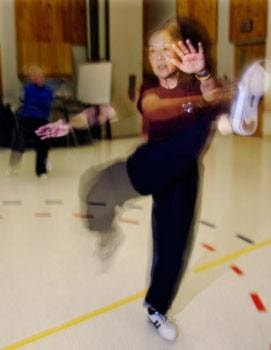‘Come on, Woods!” the cadets yelled over the rumble of the quick moving water surging through Miles Canyon on Monday.
Suspended by two thin nylon ropes, Cadet Sophie Woods, of Scotland, precariously hung 15 metres above the current.
Woods managed to pull herself hand-over-hand across most of the gap but was stuck on a sag in the line.
“My arms hurt,” she grimaced as she struggled to reach the outstretched hand of 2nd Lieut. Hannah Colwell who was perched on the cliff’s edge.
As her platoon yelled out encouraging words a tour boat hove into sight from around the river’s bend, slowly fighting its way against the current.
Some of the support ropes had to be lifted out of the way. And an order was given to pull Woods back.
The exercise was part of the cadet leadership and instructor adventure course, which brought cadets from across Canada and the UK to train in Whitehorse.
It was just a training exercise.
But after watching Woods I began to feel a little uneasy.
Earlier the cadets promised me I’d get a chance to cross the rope bridge that afternoon.
But it had quickly become apparent the exercise wasn’t the easy zip line I’d expected it to be.
I was worried I wouldn’t be able to make it across.
“It’s a confidence builder,” said Warrant Officer Steve Sandahl from the Rocky Mountain Rangers based in Kamloops, BC.
With 25 years of mountaineering experience, Sandahl was overseeing the exercise.
The cadets chose Miles Canyon both for its challenging cliffs and its storied past.
“Instead of a ditch, we give them a bit of history to go across,” he said.
The rope bridging exercise is a key part of the cadets’ six-week adventure course.
The 14- to 16-year-olds built the bridge themselves using skills they learned throughout the course.
First a small cord was sent over the canyon followed by the nylon tag lines. Next the main lines, just three-centimetres thick, were strung across the gap.
The whole procedure took two hours from start to finish.
“Yesterday there were swells and standing waves,” said Sandahl as he showed a cadet how to pull in the rope.
On Monday, the platoon set a record by pulling 33 people across the canyon in a single hour.
The combination of height, distance and the strong current below meant that many precautions had to be taken.
All the cadets wore harnesses connected to a safety line, as well as helmets and life preservers.
A rescue boat was waiting down river to pluck anyone out of the water, just in case someone happened to fall in.
No one’s ever fallen, but four years ago a rope did get jammed, said Sandahl.
The cadets were able to loosen the ropes and lower the cadet down to the water to be untangled by those on the boat.
“The rope has a 57,000-pound capacity; they’re locked in there, nothing can happen to them,” said Sandahl.
He demonstrated this by grabbing the main line and shaking it back and forth causing the cadet being pulled across to tip and sway.
Cadet Thomas Luc, from Richmond, BC, was the only one from his core to take the leadership course.
“You have to compete against cadets from across Canada and the UK; I was really looking forward to it,” he said.
“Cadets is awesome; it’s the best youth program in the country,” said Staff Cadet Sgt. Josh Walker.
People join the cadets for many different reasons, he said, but for him it was just because it looked like fun.
It did look like fun and, soon enough, it was my turn to cross the canyon.
There were two rope bridges to choose from, both of which each cadet had to tackle.
The first was a tram that cadets only had to sit in and be pulled across.
The other, which Woods had tackled earlier, was called “the commando crawl,” which the cadets had to get across under their own power.
I opted for the tram.
I strapped on a bright yellow “harness for dummies” which the cadets called “the bumblebee suit” and climbed into the basket.
Everything was going smoothly until about half way across the gap when the basket started to sway and bounce.
Sandahl was again demonstrating for me the resilience of the bridge.
I held on tight, tried to look as calm as possible and waited as the cadets on the other side of the river graciously pulled me across to safety.
